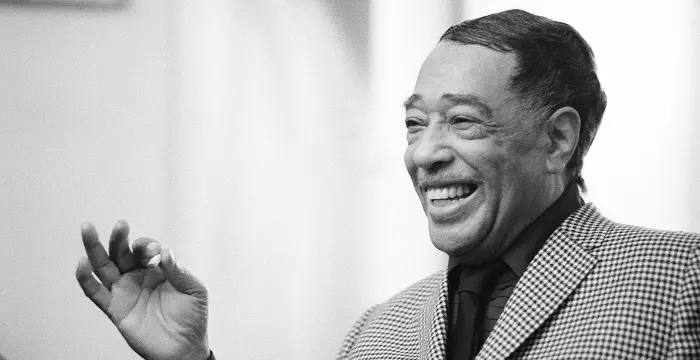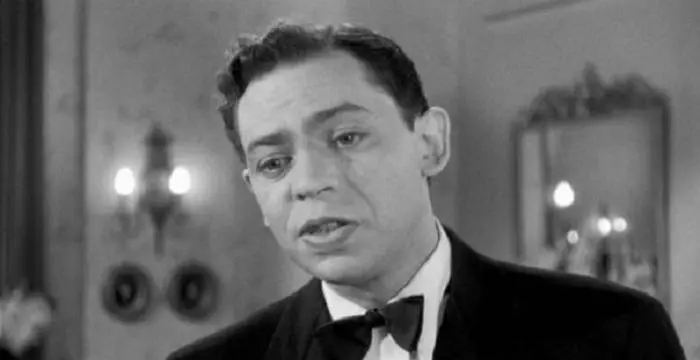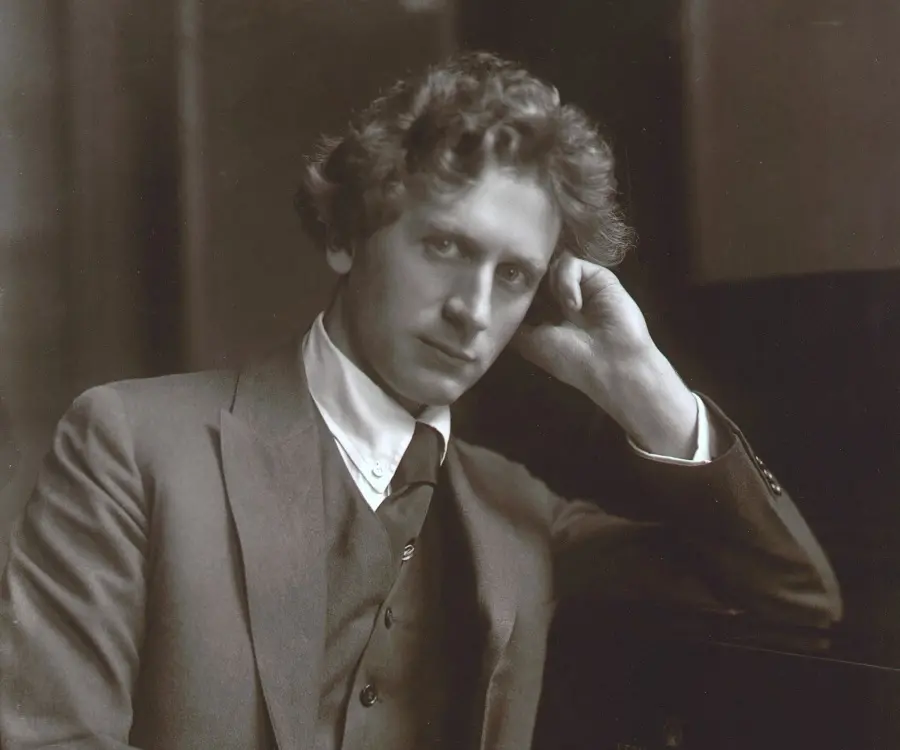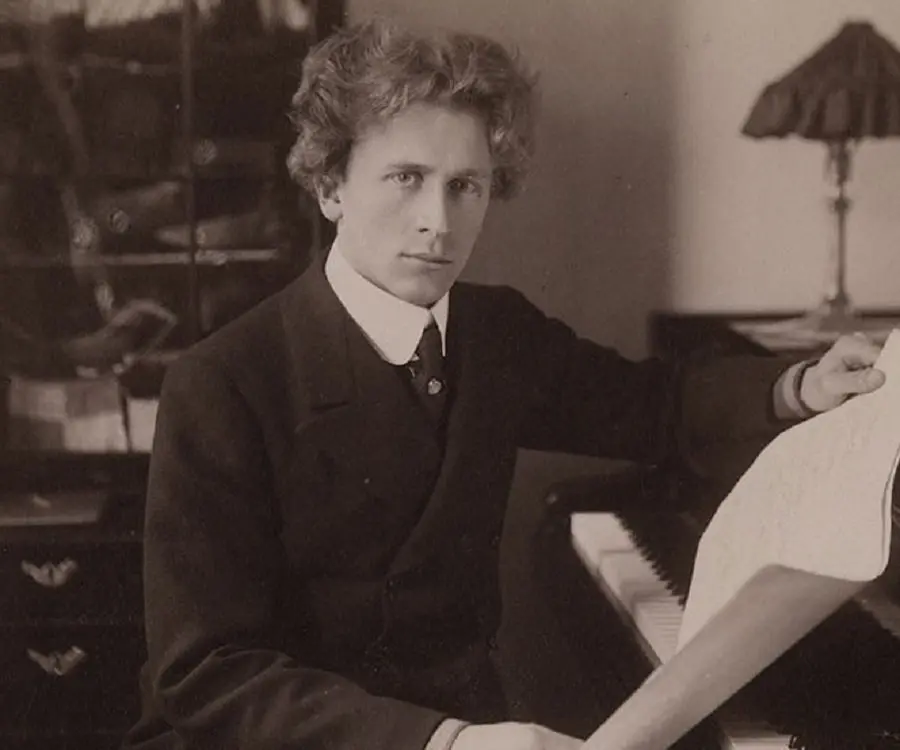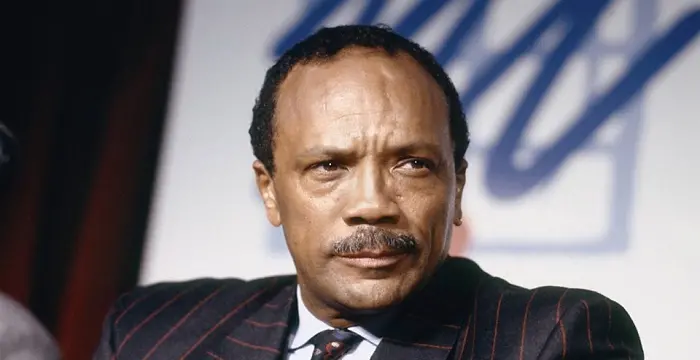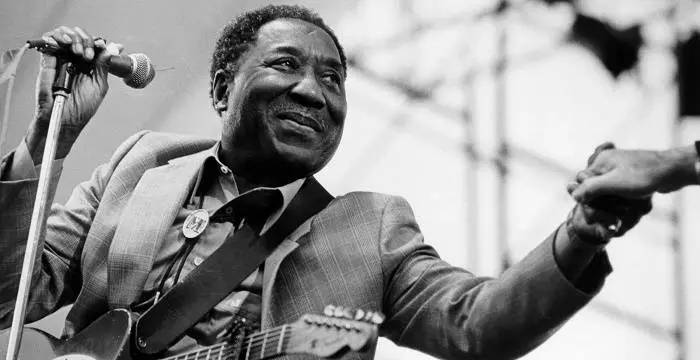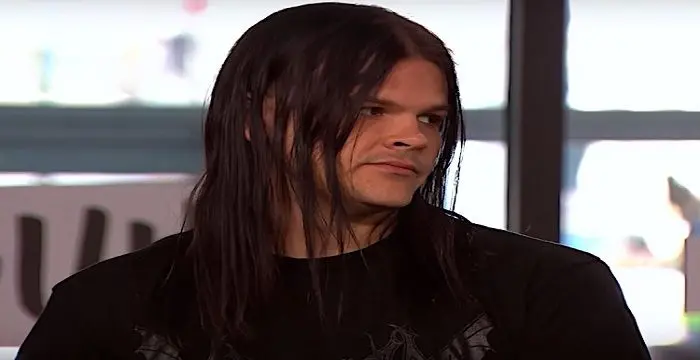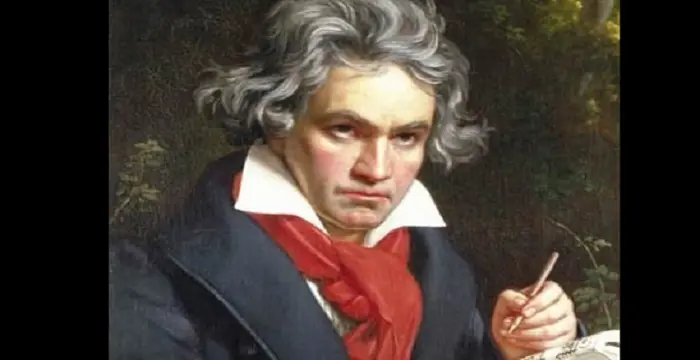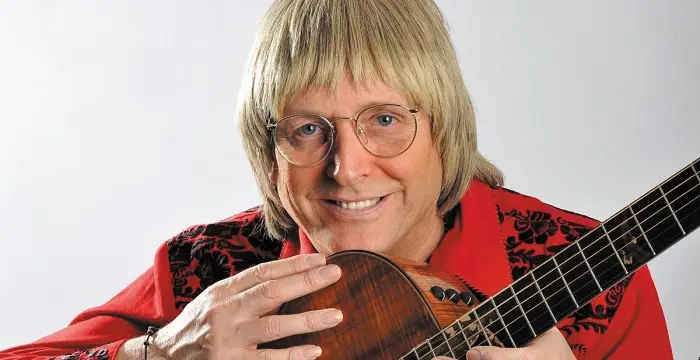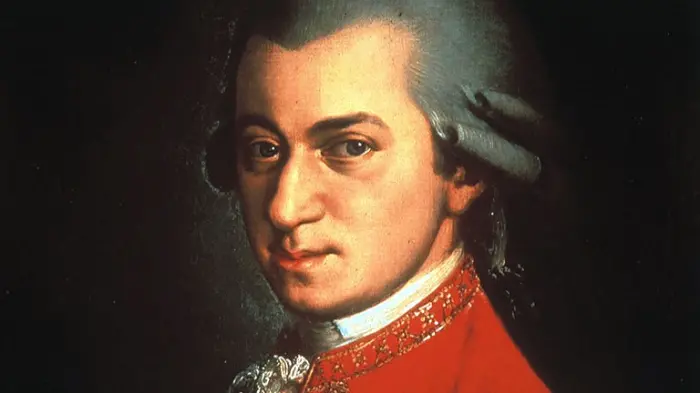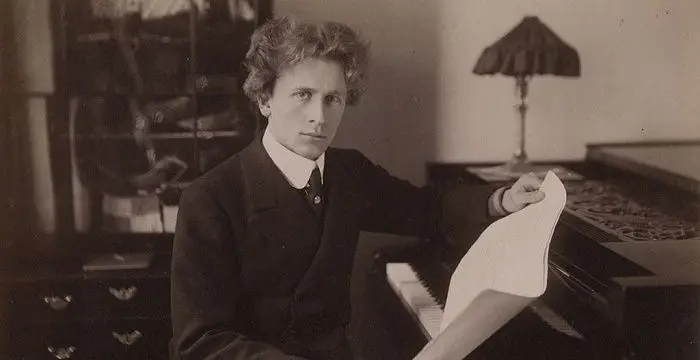
Percy Grainger - Pianists, Career and Family
Percy Grainger's Personal Details
Australian-born American composer and pianist, Percy Grainger is lauded for his eccentric music and lifestyle
| Information | Detail |
|---|---|
| Birthday | July 8, 1882 |
| Died on | February 20, 1961 |
| Nationality | Australian, American |
| Famous | Musicians, Composers, Arranger, Pianists |
| Spouses | Ella Ström |
| Known as | George Percy Aldridge Grainger |
| Universities |
|
| Birth Place | Brighton |
| Born Country | Australia |
| Gender | Male |
| Father | John Grainger |
| Mother | Rose |
| Sun Sign | Cancer |
| Born in | Brighton |
| Famous as | Musician, Composer, arranger and pianist |
| Died at Age | 78 |
// Famous Pianists
Duke Ellington
Duke Ellington was an American jazz composer and performer who is among one of the greatest names in the history of jazz. This biography profiles his childhood, life, music career, achievements and timeline.
Andy Biersack
Learn about Andy Biersack, the famous American rock singer and pianist; his birthday, what he did before fame, his family life, fun trivia facts and more.
Oscar Levant
Oscar Levant was a pianist and comedian known for playing sarcastic characters on screen. This biography of Oscar Levant provides detailed information about his childhood, life, achievements, works & timeline.
Percy Grainger's photo
Who is Percy Grainger?
George Percy Aldridge Grainger, better known to the world as Percy Grainger, was an Australian–born composer, arranger and pianist. His chief fame rests as a composer of unconventional and original music that was characterized by its shift from the standard convention. He employed meters, which were irregular and unusual. An eccentric to the core, Grainger’s private life was as celebrated and scrutinized as his works. Born in Australia to an architect father and a domineering mother, who was apparently a major influence in his life, his travels and studies took him to many countries, which included his long stay in Germany and England. He eventually settled in the United States of America. During his stay in Germany, he developed a deep interest in Nordic music, something that he carried throughout his life, taking measures to spread it across the globe. Explore more on the life and accomplishments of Percy Grainger in the biography blow.
// Famous Arranger
Quincy Jones
Quincy Jones is an American record producer, film & TV producer, composer, conductor, instrumentalist, jazz trumpeter, and record company executive. This biography provides detailed information on his childhood, life, career, achievements & timeline.
Biography detail
Percy Grainger’s Childhood and Early Life
Percy Grainger was born in Melbourne, Australia on July 8, 1882 to John Grainger and Rose Annie Aldridge. John Grainger was a British architect who had immigrated to Australia in 1877. He is popular in his own right as the designer of the famous Princes Bridge across the Yarra River, Melbourne. Rose Aldridge was the daughter of an Adelaide hotelkeeper. John was an alcoholic and a womanizer that strained his married life. The marriage eventually fell apart in 1890. This led to Rose having to shoulder the task of bringing up Percy all by herself.
Rose Aldridge was an autodidact. She was a domineering influence on Percy’s life during his childhood, traces and effects of which continued to shape and influence him throughout his life. She supervised Percy’s studies in music and literature and engaged tutors for languages, art and drama. It was in the course of these classes that Percy developed an interest for Nordic culture, which remained the greatest influence on his musical career.
Percy first began studying piano under Louis Pabst at the age of 10. Pabst, who was a German émigré, was considered the best teacher in Melbourne. It was under his tutelage that Percy produced his first known composition, ‘A Birthday Gift to Mother’ (1893) and gave his first public performance in 1894. Under his new tutor Adelaide Burkitt, Percy gave a series of concerts in October 1894 at Melbourne’s Royal Exhibition Building. These concerts were performed to great critical acclaim and established Percy Grainger as a prodigy of great potential. This reception of Percy’s talents prompted Rose to decide that Percy should pursue his musical studies at the Hoch Conservatory in Frankfurt, Germany. Rose and Percy left Australia in 1895. Percy never returned to Australia, except for visits.
Germany and Its Influences
Percy’s time at Frankfurt served at strengthening his admiration for Nordic music and culture. This was strengthened by his association with Karl Klimsch under whom he took composition classes. This arrangement came in to being, as Percy did not get along well with his composition teacher at Koch Conservatory. In addition to being a composer, Klimsch was also an enthusiast of folk – songs. It was on his encouragement that Percy moved away from the conventional compositions of the likes of Mozart, Handel and Haydn to developing his own style of original compositions.
It was while in Frankfurt that Percy formed the ‘Frankfurt Group’ along with a group of English students. The group members were all like-minded in that they considered the influence of Central European music on British and Scandinavian music as harmful. To eliminate this influence was their long–term objective. It was also in Germany that Grainger came across the poetry of Rudyard Kipling, which he composed later.
Rose, who had been working as an English teacher to support them, suffered a nervous collapse in 1900, which rendered her incapable of working. This meant that Percy had to make up the lost income by providing piano lessons and by giving public performances. His first solo recital was at Frankfurt on December 6, 1900. In 1901, when he felt confident enough that he knew enough to support himself and his mother, he abandoned his studies, left Frankfurt, and relocated to London.
Life in England
It was in England that Percy Grainger established himself as a name to reckon with in the world of music. He made his first appearance as piano soloist with orchestra in February 1902. Something significant happened in the life of Percy Grainger in 1905; it was in this year that he started collecting original versions of folk songs after being inspired by a lecture given by folksong historian Lucy Broadwood. This endeavor brought in his custody a collection of over 300 folk songs, many of which were recorded for the first time in written form. Grainger was also a pioneer in the usage of phonographs, which he used to record these songs. He had a collection of over 200 Edison cylinders with songs of native folk singers.
It was also during this period that Grainger gained enough popularity to be acquainted with famous musicians of his time. He met Frederick Delius in 1907. This was the start of a friendship that lasted until Delius’s death in 1934. His association with Edvard Hagerup Grieg, a Norwegian composer withered out even before it could blossom because of Grieg’s untimely death. Not only did the two musicians share similar ideas about composition and harmony, they even shared a dislike for the classical German masters. The similarities stretched to both liking for folk music as well. During this period, Grainger also went on tours around the world, including Australia and New Zealand. During these tours, he would collect folk songs including Mayo songs from New Zealand. In 1908, he obtained the tune of his famous ‘Country Songs’, though it was only much later that he gave it the form of a performable piece.
It was also in this period that he composed some of his most famous pieces such as ‘Mock Morris’, ‘Molly on the Shore’ and ‘Shepherd’s Hey’ among others. By 1911, he was confident that he had established himself as a top pianist and started publishing his own works. In 1912, at a concert at the Aeolian Hall in London, Grainger, for the first time, presented a concert where only his works were performed.
Settling in America
In 1914, when the World War I broke out, Percy Grainger with his mother left England for the United States of America. After a few tours of the country and many concerts over two years and having applied for the citizenship there, Grainger joined the U.S army as bandsman in Coast Artillery Corps. It was during this tenure that Grainger set to tune the piece ‘Country Gardens’, the work that tends to be associated with him more than any other works of his. In June 1918, Grainger became a naturalized U.S. citizen.
The years, which immediately followed the war, saw the best of Percy Grainger. He was performing up to 120 concerts a year. His audience multiplied manifold when he performed at New York’s Capitol Theatre. Another important event from this period was Grainger’s first role as educationist when he led a course in piano technique at the Chicago Musical College.
Another habit he developed during this period was rescoring his own works, which continued through the rest of his life. In addition to composing new pieces, Grainger worked on a technique of elastic scoring. This particular form of orchestration allowed a piece to be played by as many musicians and types of instruments that the setting permitted, from a small chamber performance to a full-fledged orchestral performance.
In 1921, he set up his residence in White Plains, New York and stayed there for the rest of his life. His life there started tragically. Rose, whose health was deteriorating alarmingly, was plagued by constant nervous breakdowns. Moreover, to add to the woe, some of their close friends suspected her relationship with her son to be incestuous. She took her life on 30 April 1922 by jumping of a building when Percy was on a tour of the West Coast.
Rose’s death, while in itself a massive loss to Grainger, also served to free him from constrains of a relationship, which was often a hindrance to the growth of other relationships with women. In fact, Grainger was briefly engaged to a student of his while in England, but did not go further with it allegedly because of Rose’s possessiveness.
In 1926, while returning from one of his travels to Europe, Grainger met Ella Strom, a Swedish–born artist. They married two years later.
Beginning in the late 1920’s and continuing through the 30’s, Grainger took up many projects in his role as an educationist. He even served as the professor of music at New York University for the academic year 1932–1933. During this tenure, he did his best to introduce the students to a wide range of ancient and modern works. However, it was not a happy association due to Grainger’s dislike for rigid institutional formality and the university’s perceived lack of reception for his ideas. As a result, Grainger never again accepted another academic post. He also refused all honorary degrees. However, he did teach at the summer schools conducted by Interlochen International Music Camp from 1937 to 1944.
The Grainger Museum
The Grainger Museum was first thought about in the year 1932. Grainger wanted it to be his legacy. The museum would contain all artifacts, including very personal items that would serve the purpose of propagating his works and musical philosophy.
His Life and Philosophy
Grainger was an advocate of ‘free–music’ (as he called it). This form was a reflection of Grainger’s apathy towards the ‘constrains’ that a fixed meter, note and pitch place on the production of music. He argued that many Nordic masters were much greater than accepted masters like Mozart and Beethoven were. He even went about rescoring the works of many other composers to accommodate them into his own views. He was of the view that machines should perform ‘free–music’.
The years before the war were spent in performing concerts with the purpose of financing the construction of the museum. He also toured across the globe and composed some more pieces.
The Last Years
The eruption of the Second World War meant that Grainger could no longer travel abroad frequently. He spent much of the war years doing concerts for charity. His exhaustive schedule led him to perform up to 140 concerts in a year. This busy schedule resulted in weakened health post–war. In addition, it triggered the decline of Percy Grainger as a composer.
Disillusionment about his life and works started to dominate his thoughts to the extent that he started considering his life a failure. He even grew to despise his most popular composition, ‘Country Gardens’. His perceived failure to promote the Nordic music and the prevalent influence of German music contributed to the disillusionment by no small means.
By 1950, Grainger had stopped composing any new works. He limited himself to rescoring works, both his own and others. However, much of his efforts involved his endeavors to build machines, which would produce music when fed with the notes by the composer. To this purpose, he worked with Burnett Cross, a physics teacher. The pair even succeeded in developing a few machines to partial success. He visited Australia for the last time in 1955 and spent his time there on work related to the museum. A feather in the cap was the St. Olav medal he received in 1954 from King Haakon of Norway in recognition for his promotion of Grieg’s works. The 50’s also saw Grainger having to undergo operation for abdominal cancer, an ailment that he had to fight against the rest of his life.
His last years were marked by declining health. He gave his last public concert on 29 April 1960 at Dartmouth College in Hanover. Loss of concentration and hallucinations plagued him even while he tried to work.
Percy Grainger died in White Plains on 20 February 1961, aged 78. He was buried in the Aldridge family vault in West Terrace Cemetery, Adelaide.
Grainger will be remembered for the contributions and effort he put in to have the folk songs recorded. Enthusiasts have him to thank for the collection that they are now able to access; were it not for him many songs would have gone in to oblivion. The music scene in the United States also bears the influence of his works. He will be remembered for the innovation and eccentricity that he brought to the music world.
// Famous Musicians
Ted Nugent
Ted Nugent is a hard rock musician known for his hits ‘Stranglehold’ and ‘Cat Scratch Fever’. This biography of Ted Nugent provides detailed information about his childhood, life, achievements, works & timeline.
Muddy Waters
Muddy Waters was a blues musician referred to as the 'father of modern Chicago blues.' Check out this biography to know about his childhood, family life, achievements and fun facts about him.
Travis Bacon
Travis Bacon is an American musician and actor, better known as the son of veteran actors Kevin Bacon and Kyra Sedgwick. Find more about his family, birthday, etc.
// Famous Composers
Ludwig van Beethoven
Ludwig Van Beethoven was one of the greatest composers the world has ever had. Check out this biography to know about his childhood, family life, and achievements.
Emina Jahović
Emina Jahović Sandal is a Serbian model, actress and singer-songwriter. Know more about her childhood, life, career, achievements and timeline in this biography.
John Denver
John Denver, a famous American singer-songwriter and activist, is remembered for songs like Take Me Home, Country Roads and Annie's Song. To know more about his childhood, career, profile and timeline read on
Joan Jett
Joan Jett is an American rock singer, musician, composer, actress, and record producer. This biography profiles her childhood, family, personal life, career, etc.
Dizzy Gillespie
Dizzy Gillespie was one of the greatest jazz trumpeters of all times. Check out this biography to know about his childhood, family life, achievements and other facts related to his life.
Wolfgang Amadeus Mozart
Wolfgang Mozart was one of the most prolific composers whose name is written in golden letters in the history of music. Read on and learn more about Wolfgang Amadeus Mozart Profile, Childhood, Life, and Timeline.
Percy Grainger's FAQ
What is Percy Grainger birthday?
Percy Grainger was born at 1882-07-08
When was Percy Grainger died?
Percy Grainger was died at 1961-02-20
Where was Percy Grainger died?
Percy Grainger was died in White Plains
Which age was Percy Grainger died?
Percy Grainger was died at age 78
Where is Percy Grainger's birth place?
Percy Grainger was born in Brighton
What is Percy Grainger nationalities?
Percy Grainger's nationalities is Australian, American
Who is Percy Grainger spouses?
Percy Grainger's spouses is Ella Ström
What was Percy Grainger universities?
Percy Grainger studied at Hoch Conservatory
Who is Percy Grainger's father?
Percy Grainger's father is John Grainger
Who is Percy Grainger's mother?
Percy Grainger's mother is Rose
What is Percy Grainger's sun sign?
Percy Grainger is Cancer
How famous is Percy Grainger?
Percy Grainger is famouse as Musician, Composer, arranger and pianist
